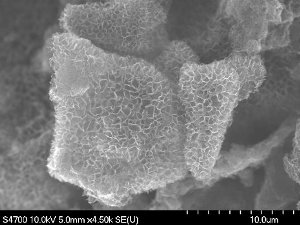Aug 21 2013
One of the most promising types of solar cells has a few drawbacks. A scientist at Michigan Technological University may have overcome one of them.
 A field emission scanning electron microscopy (FESEM) image of 3D honeycomb-structured graphene. The novel material can replace platinum in dye-sensitized solar cells with virtually no loss of generating capacity. Hui Wang image
A field emission scanning electron microscopy (FESEM) image of 3D honeycomb-structured graphene. The novel material can replace platinum in dye-sensitized solar cells with virtually no loss of generating capacity. Hui Wang image
Dye-sensitized solar cells are thin, flexible, easy to make and very good at turning sunshine into electricity. However, a key ingredient is one of the most expensive metals on the planet: platinum. While only small amounts are needed, at $1,500 an ounce, the cost of the silvery metal is still significant.
Yun Hang Hu, the Charles and Caroll McArthur Professor of Materials Science and Engineering, has developed a new, inexpensive material that could replace the platinum in solar cells without degrading their efficiency: 3D graphene.
Regular graphene is a famously two-dimensional form of carbon just a molecule or so thick. Hu and his team invented a novel approach to synthesize a unique 3D version with a honeycomb-like structure. To do so, they combined lithium oxide with carbon monoxide in a chemical reaction that forms lithium carbonate (Li2CO3) and the honeycomb graphene. The Li2CO3 helps shape the graphene sheets and isolates them from each other, preventing the formation of garden-variety graphite. Furthermore, the Li2CO3 particles can be easily removed from 3D honeycomb-structured graphene by an acid.
The researchers determined that the 3D honeycomb graphene had excellent conductivity and high catalytic activity, raising the possibility that it could be used for energy storage and conversion. So they replaced the platinum counter electrode in a dye-sensitized solar cell with one made of the 3D honeycomb graphene. Then they put the solar cell in the sunshine and measured its output.
The cell with the 3D graphene counter electrode converted 7.8 percent of the sun’s energy into electricity, nearly as much as the conventional solar cell using costly platinum (8 percent).
Synthesizing the 3D honeycomb graphene is neither expensive nor difficult, said Hu, and making it into a counter electrode posed no special challenges.
The research has been funded by the American Chemical Society Petroleum Research Fund (PRF-51799-ND10) and the National Science Foundation (NSF-CBET-0931587). The article describing the work, “3D Honeycomb-Like Structured Graphene and Its High Efficiency as a Counter-Electrode Catalyst for Dye-Sensitized Solar Cells,” coauthored by Hu, Michigan Tech graduate student Hui Wang, Franklin Tao of the University of Notre Dame, Dario J. Stacchiola of Brookhaven National Laboratory and Kai Sun of the University of Michigan, was published online July 29 in the journal Angewandte Chemie, International Edition.